I work for a magazine company in Sydney that, among other things, does a lot of cookbooks. The recipes have to be tested and tested again – the magazine where I do the bulk of my work tests each recipe at least three times. The problem is, when they cook something, again and again and again, someone has to eat it afterwards, again and again and again, otherwise the food goes to waste. It’s an onerous job, but I volunteer for it. My motto: my waist = no waste.
On Friday, for example, the food team was photographing and filming its Christmas day meals for the December edition of the magazine. So I had to tuck into a huge Christmas lunch. The things I do for journalism.
I live near the Portuguese precinct in Sydney, where there are a couple of great Portuguese bakeries/patisseries (Fernandes Patisserie and Sweet Belem). I feel sorry for the bakers who go to such hard work making these delicacies, so whenever I am passing I go in and buy some and consume them just to cheer them up. The things I do for humanity.
One day I was feeling very generous (and a bit peckish) so I bought a big box – or about two dozen – of the various Portuguese tarts to take into the office. My plan was about to eat about a dozen myself and let my 20-odd co-workers have half of one each, but the greedy buggers wanted a complete one, or two! I was lucky to get a nibble. What surprised me was, even though this magazine has a fine cooking and baking tradition, few people in the office had eaten Portuguese tarts before. OMG!!! Where have you been, do you know what you are missing out on!!??
So if you find yourself in the same boat – a boat that has not yet pulled up at the docks in Belém in Lisbon where the famous Portuguese tarts were invented – this Portuguese tart sampler is for you. (The pictures were taken on my phone through the glass counter at Fernandes, so there is glare from the overhead lights reflected in the glass, and I have included the tags for descriptive and language purposes, even though they are not particularly attractive.)
Pastel de nata
 This is the king of Portuguese tarts! Bow down in homage, you will never find a tart better than this. Pastel means pastry, nata means custard, buttermilk or cream, but don’t confuse it with the the ordinary commercial custard that you can make from packets or buy ready made. This is a delicious creamy concoction of egg and sugar on a crisp flaky base. The history of this tart is interesting – you can read about it here. Incidentally, I have been to the famous patisserie in Belem that has to churn out 15,000 of these on busy days to cater for the demand from salivating tourists and passers-by, but I prefer the ones in Sydney. Other patisseries may add their own twist to the recipe – down in Lagos in southern Portugal, for example, I came across some with puréed maça (apple) added to the mix. These tarts are best eaten in the plural, which is pastéis.
This is the king of Portuguese tarts! Bow down in homage, you will never find a tart better than this. Pastel means pastry, nata means custard, buttermilk or cream, but don’t confuse it with the the ordinary commercial custard that you can make from packets or buy ready made. This is a delicious creamy concoction of egg and sugar on a crisp flaky base. The history of this tart is interesting – you can read about it here. Incidentally, I have been to the famous patisserie in Belem that has to churn out 15,000 of these on busy days to cater for the demand from salivating tourists and passers-by, but I prefer the ones in Sydney. Other patisseries may add their own twist to the recipe – down in Lagos in southern Portugal, for example, I came across some with puréed maça (apple) added to the mix. These tarts are best eaten in the plural, which is pastéis.
Bolinhos de leite
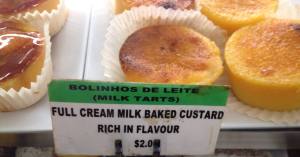 A bolinho is a sweet or savoury delicacy that has been rolled into a little ball, leite means milk. Think of these bolinhos de leite on the right as pastéis de nata without the pastry. They are moist and clammy and wobbly – I pop them into my mouth very quickly as I’m afraid they’ll wobble their way onto the floor. The ones on the left are similar but with some kind of sugary glaze on them. This is not food for diabetics!
A bolinho is a sweet or savoury delicacy that has been rolled into a little ball, leite means milk. Think of these bolinhos de leite on the right as pastéis de nata without the pastry. They are moist and clammy and wobbly – I pop them into my mouth very quickly as I’m afraid they’ll wobble their way onto the floor. The ones on the left are similar but with some kind of sugary glaze on them. This is not food for diabetics!
Mystery tart
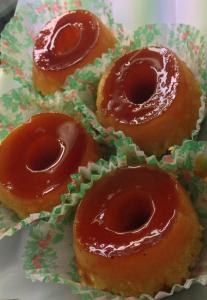 These caught my eye as I was leaving the cafe. If I had seen them earlier I would have ordered one, or two or three or possibly all four. From memory they are similar to the bolinhos de leite but have coconut in them to give them a bit of substance, plus of course that delicious glaze on top.
These caught my eye as I was leaving the cafe. If I had seen them earlier I would have ordered one, or two or three or possibly all four. From memory they are similar to the bolinhos de leite but have coconut in them to give them a bit of substance, plus of course that delicious glaze on top.
Bolo de Berlim
 This is basically the Portuguese version of the Berliner doughnut. The ones pictured here have a custard filling, but there are many variations, including jam fillings. When I was doing a summer language course at the University of Algarve, the cafeteria there had a delicious jam variation (the filling is often hidden inside). A bolo de Berlim became my customary breakfast or mid-morning snack. It was the best thing I learnt on the course (haha).
This is basically the Portuguese version of the Berliner doughnut. The ones pictured here have a custard filling, but there are many variations, including jam fillings. When I was doing a summer language course at the University of Algarve, the cafeteria there had a delicious jam variation (the filling is often hidden inside). A bolo de Berlim became my customary breakfast or mid-morning snack. It was the best thing I learnt on the course (haha).
Pastel de amêndoa
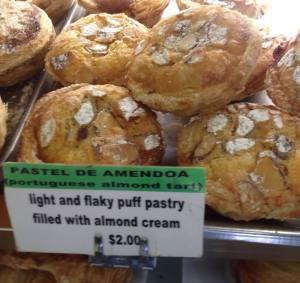 Once you have scoffed a few pastéis de nata or bolinhos de leite, you will probably want something a little drier and more solid to counter the creamy custard. If you like amêndoa (almond), half a dozen of these should do!
Once you have scoffed a few pastéis de nata or bolinhos de leite, you will probably want something a little drier and more solid to counter the creamy custard. If you like amêndoa (almond), half a dozen of these should do!
Pastel de feijão
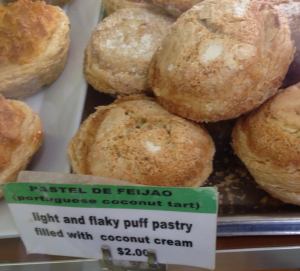 I don’t know why these coconut tarts are labelled as feijão (which normally means bean) but who cares. Maybe there are some beans in there so you can get your vegetable quota at the same time! The word for coconut in Portuguese is coco.
I don’t know why these coconut tarts are labelled as feijão (which normally means bean) but who cares. Maybe there are some beans in there so you can get your vegetable quota at the same time! The word for coconut in Portuguese is coco.

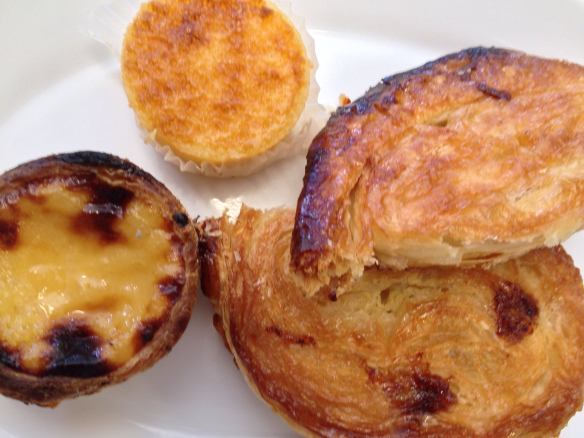

Great post!! Mystery tart might be Bolinho de Leite de Coco e Pudim Suíço. I would have never been able to walk out without having a few. Portuguese pastries are the BEST!
Hi, thanks for your feedback. A Bolinho de Leite de Coco e Pudim Suíço is top of my shopping list!
Oh oh oh! Thanks for a perfect Sunday breakfast 🙂
On Friday, my Portuguese teacher gave me a packet of Queijadas de Sintra – my faves!!! They didn’t survive till Saturday, never mind Sunday.
http://www.thekitchn.com/queijadas-de-sintra-sintra-che-77981
Hello there, I don’t think I have tried those Queijadas, but they look great.
You MUST next time you get the chance. They are nothing like cheesecake, despite what the name might make you believe. I love everything with cinnamon in, and they have plenty 🙂
Oh my word – I like this on so many different levels
I totally agree with the naughty Natas!! The most delectable morsel to have ever passed my lips …. Ever!!!
Iam so sold!